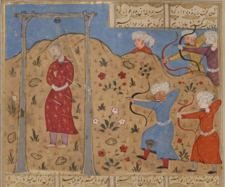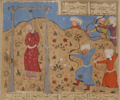Mazdak facts for kids
Quick facts for kids Mazdak |
|
 Illustration of the execution of Mazdak from a copy of the Shahnameh |
|
| Died | c. 524 or 528 in |
|---|---|
| Nationality | Iranian |
Mazdak (Persian: مزدک) was an important religious leader and reformer in ancient Iran. He lived around 500 AD during the time of the Sasanian Empire. Mazdak was a mobad, which means a priest in the Zoroastrian religion. He believed he was a prophet sent by Ahura Mazda, the main god in Zoroastrianism. Mazdak wanted to make society fairer for everyone.
Contents
What Was Mazdakism?
Mazdak taught a special set of beliefs called Mazdakism. He saw it as a new and better version of Zoroastrianism. However, many other Zoroastrian priests thought his ideas were wrong. Mazdak's teachings also had some ideas similar to other ancient beliefs.
How Did Mazdakism Start?
Some people say that the ideas of Mazdakism began before Mazdak himself. There might have been an older priest named Zaradust or an older philosopher also called Mazdak. These earlier thinkers talked about being kind to others and enjoying life.
Mazdak the Younger, son of Bāmdād, developed these ideas further. His followers were sometimes called "the first socialists." This is because they believed in sharing property and working together for everyone's benefit.
Mazdak's Main Beliefs
Like Zoroastrianism, Mazdakism believed in two main forces in the universe. These were Light (which was good) and Darkness (which was evil). They thought these two forces got mixed up by accident. Mazdak taught that people should live good lives to help the good parts within themselves connect with the Light.
Mazdakism also focused less on strict religious rules. Instead, it emphasized understanding the universe's principles. Mazdak also criticized the powerful priests of his time. He believed they were making life hard for many people and causing poverty.
Fairness and Sharing
Mazdak taught that God originally meant for everyone to share resources equally. But, he believed that strong people took too much, leading to unfairness. He said this unfairness created "Five Demons" that pulled people away from what was right. These demons were Envy, Wrath, Vengeance, Need, and Greed.
To fight these evils, Mazdak believed that fairness must return. He thought everyone should share any extra things they had with others. He wanted to make wealth common or redistribute it. This idea of sharing is why some people call his movement an early form of "communism" or social revolution.
Mazdak's Supporters
Mazdak's ideas became very popular. Even King Kavadh I, who ruled from 488 to 531, became a follower of Mazdakism. With the King's support, Mazdak started many social reforms.
He promoted peace and helped the poor. Mazdak had government storage buildings opened so poor people could get food and supplies. He also had many Zoroastrian fire temples closed, keeping only the three most important ones open.
End of Mazdakism
The nobles and Zoroastrian priests became very worried about Mazdak's growing power. Because of this, King Kavadh was removed from his throne in 496. However, he managed to become king again three years later.
After getting his throne back, King Kavadh started to distance himself from Mazdak. He allowed his son, Anushiravan, to lead a campaign against the Mazdakites. Around 524 or 528, most of Mazdak's followers were killed, including Mazdak himself. After this, the original Zoroastrian religion became the official state religion again.
Mazdak's Lasting Impact
Even after the main crackdown, some Mazdakites survived. They lived in hidden areas for many centuries. Their ideas likely mixed with other religious movements in the region. These new groups sometimes led powerful religious and revolutionary movements later on.
For example, the Khurramites in the 9th century were an egalitarian group. They might have come from Mazdakism. They led a big revolt against the Abbasid Caliphate and held a lot of land for about twenty years.
Over time, the name "Mazdakite" became a way to describe any group in Iran that wanted radical equality. While some saw Mazdak as a social reformer, traditional Zoroastrian writings remember him as a dangerous enemy of their faith.
Even in the 17th century, a writer claimed to have met people who secretly followed Mazdakism. They had a book called the Desnad, which contained Mazdak's teachings.
More recently, the philosopher and poet Muhammad Iqbal compared Karl Marx (who developed the idea of communism) to Mazdak. Iqbal saw similarities between their ideas about sharing wealth, reducing strict religious rules, and social revolution.
Images for kids
-
Illustration of the execution of Mazdak from a copy of the Shahnameh
See also
 In Spanish: Mazdak para niños
In Spanish: Mazdak para niños
- List of Persian figures in the Sasanian era
- Mandaeism
- Proto-Indo-Iranian religion
- Yazdânism


